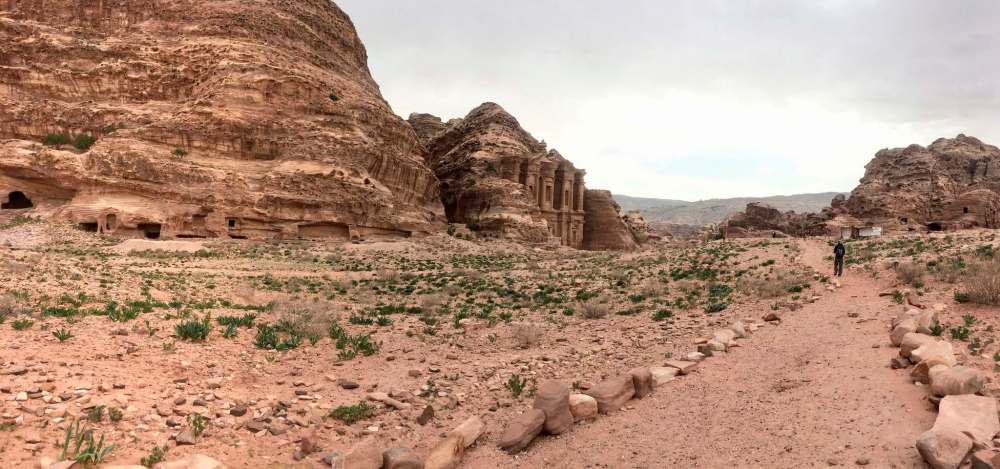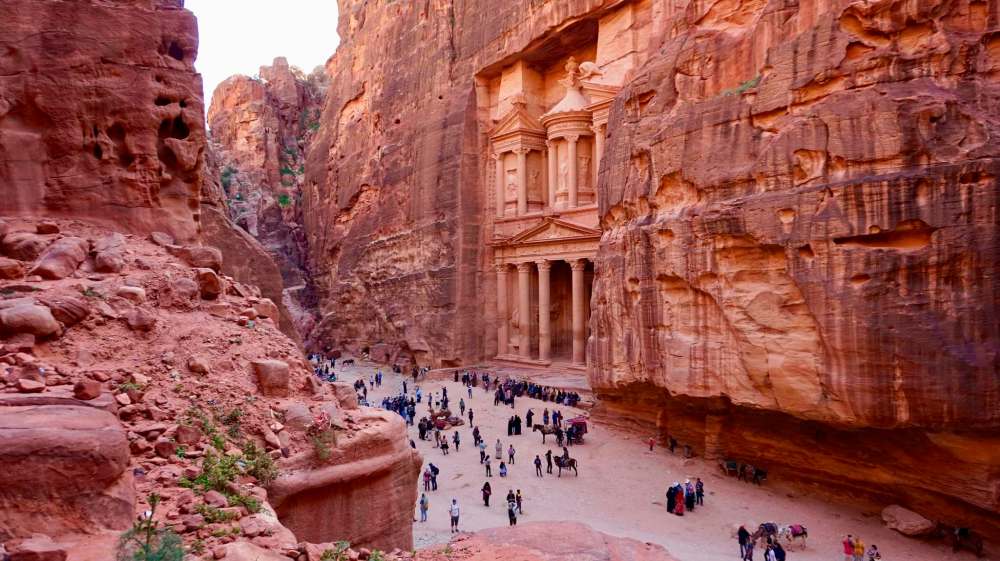A cup of tea like no other
Petra is a wonder and Jordan landscape in Wadi Rum is like something from another planet
Advertisement
Read this article for free:
or
Already have an account? Log in here »
To continue reading, please subscribe:
Monthly Digital Subscription
$19 $0 for the first 4 weeks*
- Enjoy unlimited reading on winnipegfreepress.com
- Read the E-Edition, our digital replica newspaper
- Access News Break, our award-winning app
- Play interactive puzzles
*No charge for 4 weeks then billed as $19 every four weeks (new subscribers and qualified returning subscribers only). Cancel anytime.
Read unlimited articles for free today:
or
Already have an account? Log in here »
Hey there, time traveller!
This article was published 03/05/2019 (1813 days ago), so information in it may no longer be current.
WADI RUN, Jordan — It was a cup of tea like no other.
It tasted different.
It smelled different.
It was made differently.
And it was savored in a place more unique than any other location I’d ever had a cup of tea.
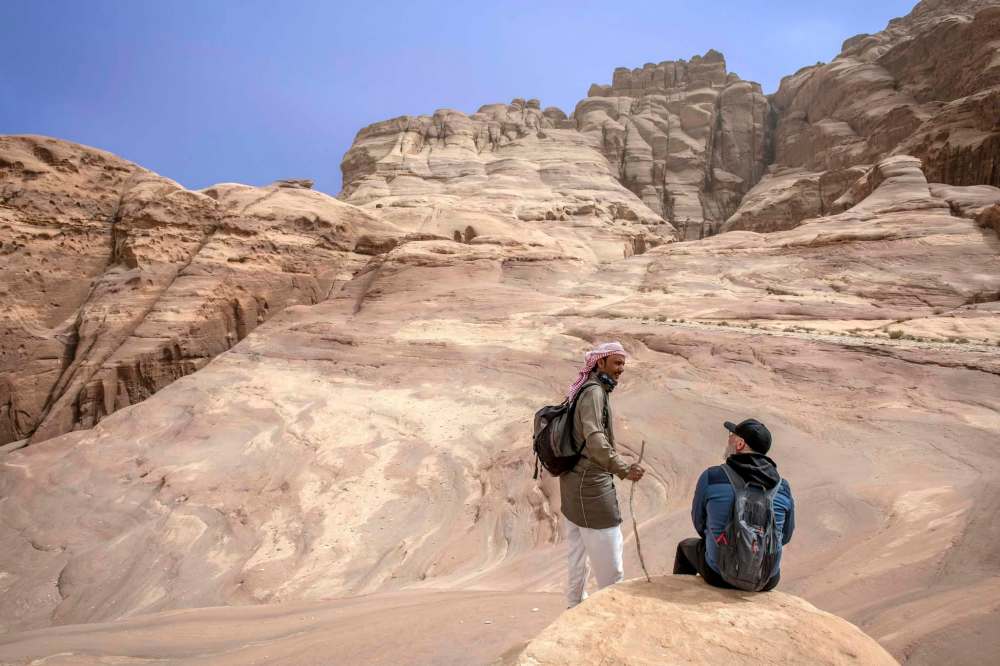
Our group is about three hours into its first hike, when I notice our guides starting to collect some shrubbery for a fire. The climb has been steady and it looks like we’re nearing some sort of summit. Wishful thinking.
As we turn the corner, the breathtaking view reveals iteself. About 1,700 meters up, the top of Jabel Al Hash offers a view of the vast desert landscape. It’s hazy, but we’re told on a clear day you can see where Jordan meets Saudi Arabia. I get a text message welcoming me to the neighbouring nation while atop the mountain — yes folks, there is cell service.
While our group snaps photos and takes a breather, two of our guides — Salem and Anas — work at getting a fire going. With a special touch of Bedouin hospitality, Salem adds wild thyme and black tea to the boiling water and Anas passes around a bag of delicious toasted sesame seed cookies.
On this same trip to Jordan I had the pleasure of attending a conference in Aqaba where one of the keynote speakers — Celine Cousteau (yes, the granddaughter of Jacques) — said traveling to foreign places is ‘an opportunity to explore ourselves in another place.’
As I lean against the boulder at the top of Jabel Al Hash to savour my tea and cookie, I feel an incredible sense of gratitude to be who I am in that moment and in that place.
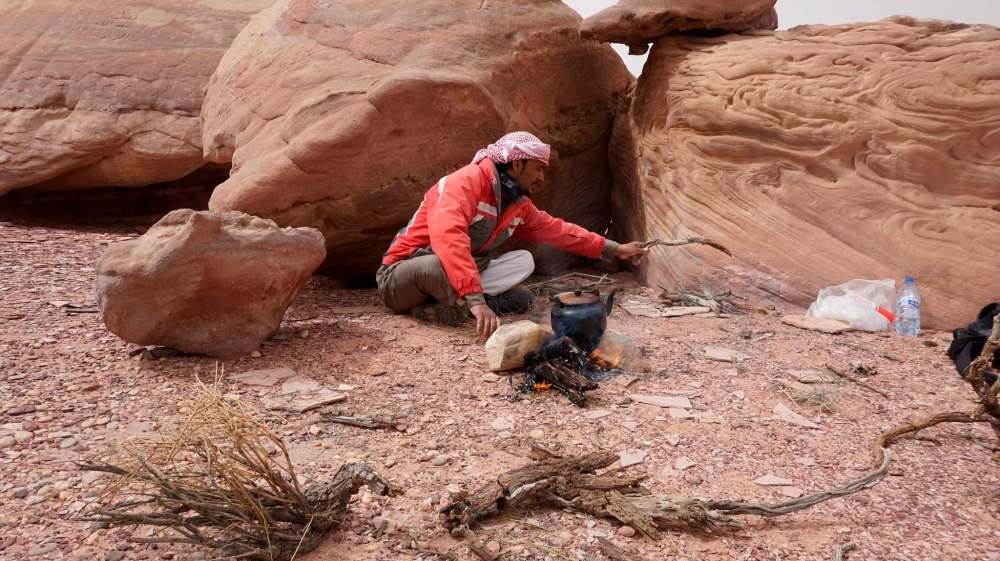
T.E. Lawrence, the British archaeologist and army officer who inspired the Peter O’Toole character in the 1962 film Laurence of Arabia, described Wadi Rum as ‘vast, echoing and God-like.’
Lawrence passed through the area several times during the Arab Revolt of 1917-18, a campaign led by King Hussein bin Ali against the Ottoman Turks in a bid to establish an independent Arab nation. He makes many references to Wadi Rum in his book ‘The Seven Pillars of Wisdom’, a title apparently inspired by one of the area’s imposing mountains.
The landscape is like something from another planet so it’s not surprising it’s often called the Valley of the Moon and has been used to film such other-worldy films as The Martian starring Matt Damon and Rogue One: A Star Wars story.
Included on the UNESCO World Heritage list, Wadi Rum has been inhabited since prehistoric times over 20,000 petroglyphs and 20,000 inscriptions have been documented in the area — tracing human existence back approximately 12,000 years in this spot.
It lies in the far south of Jordan, set on a high plateau at the western edge of the Arabian desert. Gargantuan rock formations, rippled sand dunes and clear night skies create an almost fairytale setting.
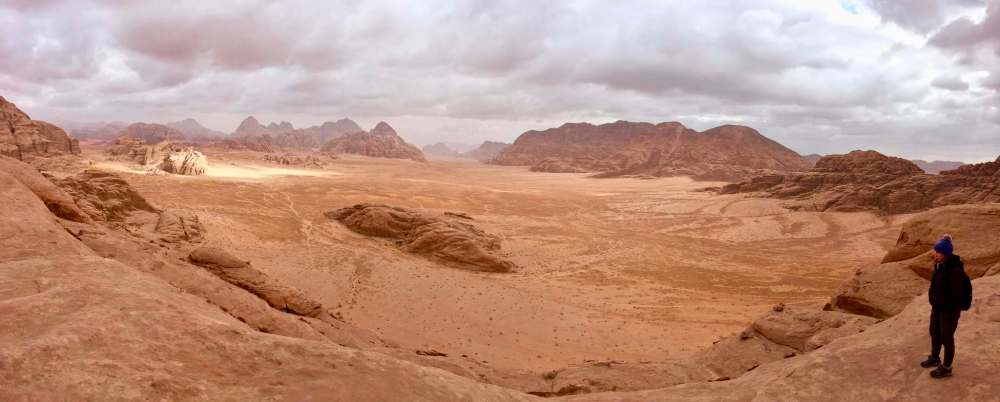
We arrive in Wadi Rum in the late afternoon after a 50-km off road mountain bike ride. After some ice cream at the visitors centre — travelers tip here: be sure to get some for everyone on the bus: duh — we make our way to our camels that will haul us to our camp.
Having not ridden a camel previously, I approached mine with some trepidation. Someone later asked me how you get on them — they squat down for you thankfully.
Our group heads out and the ride is a slow saunter that in fact was quite relaxing and a terrific way to first have a chance to gaze at and admire the Wadi Rum landscape.
Salem Camp is located close to Sunset place, in the protected area of Wadi Rum. Surrounded by desert and mountains, it offers traditional Bedouin-style accommodation with tents that are equipped with mattresses, blankets and pillows. Showers and toilets are shared in a separate enclosed tent. The camp uses solar power, so all tents are fitted with power sockets.
Wadi Rum desert camps have become a tourism staple in Jordan with Bedouin-style camping in the desert exploding in popularity. The options range from modest, authentic tented camping to full-on luxury glamping. We’ll call Salem’s property mid-range. One of the most remote camps in Wadi Rum, it gives you a great sense of seclusion.
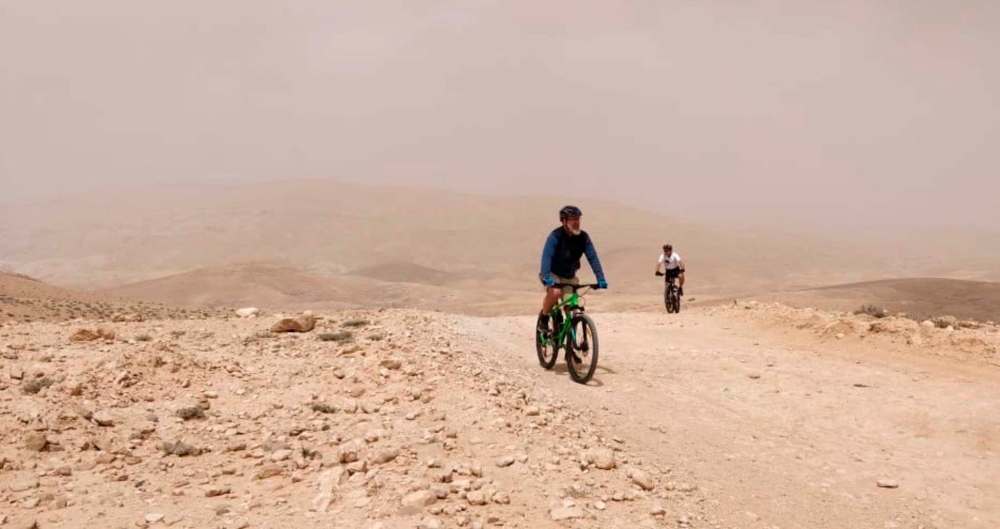
After getting settled into my tent, I meet the gang and other guests in the main tent where Salem is pouring warm tea and offering warm hospitality, entertaining his guests with his stories and witty sense of humour.
The father of four represents an ancient culture in the most gentlemanly manner. I asked him at one point during our stay if he ever took time to visit the city or travel to another place: he looks at me quizzically, kinda shakes his head and says ‘nature is better.’
Shortly after 7 p.m., the star of the show is about to make its appearance — our dinner for the night has been cooked in a traditional Bedouin style, left to slow-roast in a charcoal-filled pit dug deep into the desert sand. We are called over as the chef is preparing to lift the night’s feast from the ground and everyone claps excitedly as the delicious meal of chicken and vegetables is pulled from the ground. Later in the dining tent’s buffet line, it is Salem at the end who greets you and offers you your food for the evening. This is not his house — he lives with his family — but every moment at his camp feels like you are in his his home.
I’d been hearing about the wonders of Petra my whole life — more on that in a bit — but Wadi Rum turned out to be the surprise star of my trip to Jordan.
Traveller Tip #2: It can get cool in the desert at night, so bring some warmer clothing — and thanks to my fellow travelers for sharing some of their blankets!
My trip to Jordan was an invite from the Adventure Travel Trade Association — an industry trade group that ’serves to network, educate, professionalize and promote the adventure travel industry.’
The Adventure NEXT Near East gathering in Aqaba bought together international trade and media with suppliers from Jordan and surrounding countries. Tour operators from around the world looking for local suppliers for their clients; media looking for stories; tourism boards hoping for coverage and new clients. The event also had a variety of presentations and workshops. A big shout out to Mark Edward Harris for his presentation on how to take better travel pics — you see a couple of his photos illustrating this story.
Adventure travel is described by ATTA as a trip that includes at least two of the following characteristics: physical activity, interaction with nature, and cultural learning or exchange. Hiking remains the hottest trending activity — followed by cultural, ecotourism, environmentally sustainable, culinary, cycling and safari.Adventure travel is described by ATTA as a trip that includes at least two of the following characteristics: physical activity, interaction with nature, and cultural learning or exchange. Hiking remains the hottest trending activity– followed by cultural, ecotourism, environmentally sustainable, culinary, cycling and safari
Tourism is growing faster than the global economy and other industries such as manufacturing, retail and financial and business sectors. In 2016, travel and tourism was responsible for just over 10 percent of global GDP and 10 percent of the world’s jobs (WTTC) and is valued at $683 billion in 2017 as compared to $263 billion in 2012.
Adventure tourism, dominated by small businesses in rural areas and wilderness environments, has a deeper impact on human and nature capital producing 2.6 local jobs per $100,000 USD tourism receipts, compared to mass tourism, which produces 1.5 local jobs.
On a personal note: After many years of taking your basic all-inclusive; driving; or city-visit vacations, I have found some recent adventure travel trips to be much more rewarding and appreciate being further exposed to the breadth of the the industry at the conference in Aqaba.
My visit to Wadi Rum was part of a pre-adventure folks invited to the conference in Aqaba took part in — mine was a five-day itinerary hosted by the good folks at Terhaal Adventures. (Terhaal means ‘to be in a state of constant travel’ in Arabic and refers specifically to the nomadic lifestyle of Bedouin Arabs.)
The idea for Terhaal came about when a young Jordanian couple — Tala Momani and her husband Rakan Mehyar — who spent most of their free time exploring and wandering through Jordan, quit their Jobs and signed up for a training course that would set them on the path of becoming canyoning guides. Eventually, they decided they wanted to share these natural treasures with visitors who prefer to stray off the beaten path.
Tala was with our group the entire adventure and was not only helpful in meeting our daily needs, but had a wealth of local knowledge that truly enhanced the experience.
Our itinerary started with an overnight stay and amazing dinner in Amman which was followed by:
● a day of touring and biking around the area of Dana a 500-year-old village that is situated in the edge of a large natural gorge and the location of one of Jordan’s premier nature reserves with eco-tourism facilities;
● camping overnight in tents near Little Petra;
● a morning hike into the back entrance of Petra, followed by lunch and afternoon tour in Petra;
● an overnight stay in Wadi Musa, where I happened to bump into a group of students from Westgate Mennonite Collegiate that were not shy about giving me a few Go Jets Go chats after being informed I was the sports editor at their hometown newspaper;
● a 50-km on- and off-road bike trip through the Jordanian desert;
● and finally our two-night stay at Salem’s camp in Wadi Rum.
The tour operator’s web page advises folks planning to participate in such an adventure to spend some on their fitness prior to partaking in one of their adventures — folks, the hikes and bike rides are not to be taken lightly, but there is always support staff on hand if you feel you’d like to spend a spell riding in the truck. For the record, I didn’t.
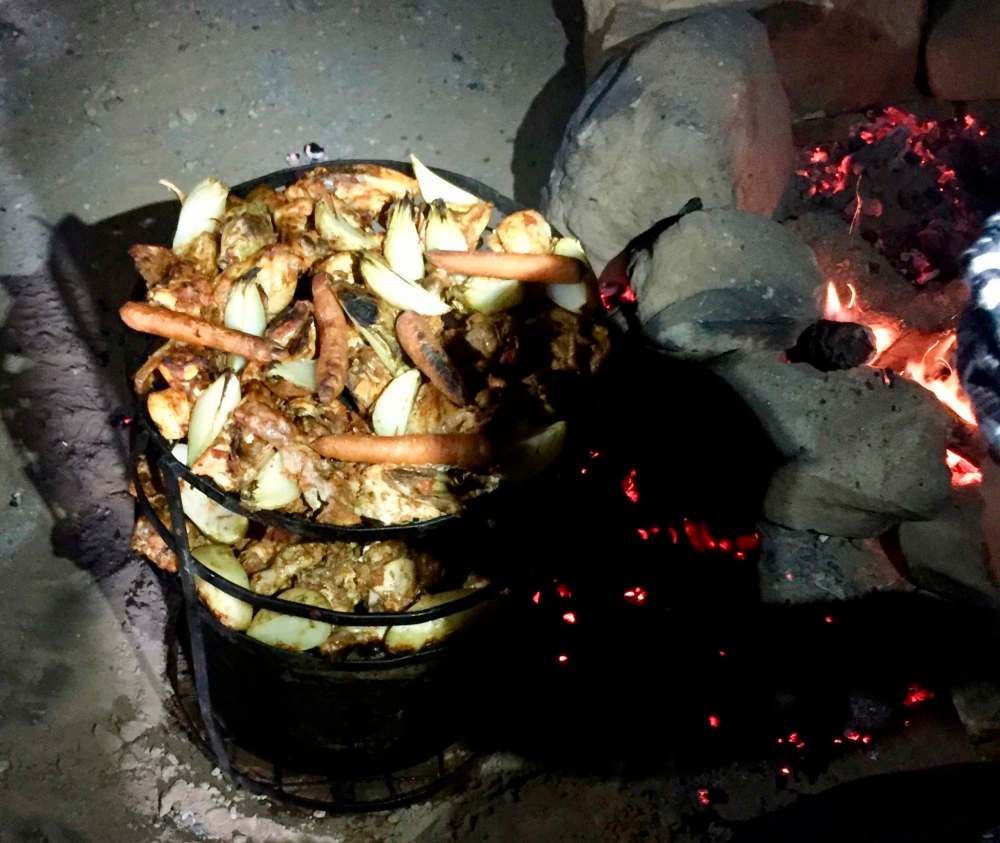
The most often question I received upon my return from Jordan was: Did you visit the Lost City?
Short answer: Of course.
Petra is a giant metropolis of tombs, monuments and other elaborate religious structures carved into stone cliffs that is ver much a symbol of Jordan and is the country’s most-visited tourist attraction.
A UNESCO World Heritage Site since 1985, the ancient city became one of the 7 New Wonders of the World when it was chosen in 2007 by a vote of 100 million people. It became known around the world with its appearance in Indiana Jones and The Last Crusade in 1989.
It was the capital of the Nabatean kingdom, a little-understood Middle Eastern culture that ruled much of modern-day Jordan from the third century B.C. until the first century A.D.
It had remained hidden from western eyes for centuries before Swiss geographer Johann Ludwig Burckhardt rediscoveed the ruins in 1812.
If you enter Petra from the back entrance as we did, it is far less crowded and the first sign of things to come is the magnificent Ad Deir (The Monastery). My favorite spot the we visited, the monumental building carved out of rock boasts a massive facade almost fifty metres square. There a couple of cafes in the area that have wonderful comfy couches that allow you to enjoy a tasty cup of tea while relaxing and enjoying this architectural marvel.
The most-visited site in Petra is Al-Khazneh (The Treasury), a structure greets visitors who enter Petra from the front entrance. Believed to have been the mausoleum of the Nabatean King Aretas IV, its arabic name comes from one legend that bandits hid their loot in a stone urn high on the second level. The area is teeming with tourists, but still magical enough to warrant finding a spot to sit and gaze at the structure.
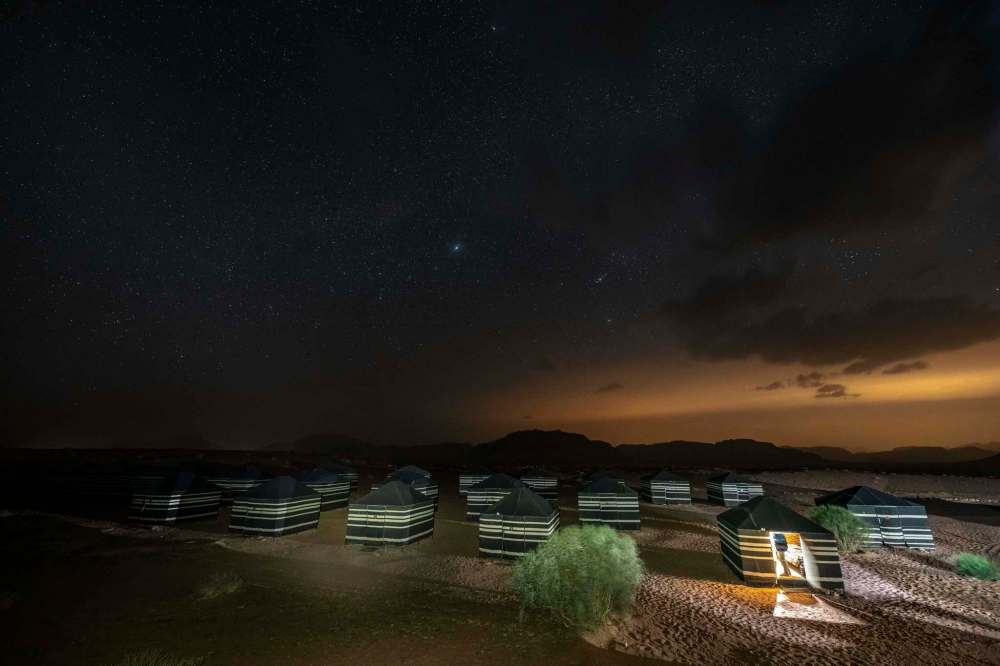
The second most often question I received upon my return was: Is it safe to visit Jordan?
There’s no doubt the nation resides in a tough neighborhood — Israel to its west, Syria and Iraq to its north and Saudi Arabia to its east — yet the kingdom has remained an oasis of calm. The democratic uprising during the Arab Spring of 2011 was only fleetingly experienced in Jordan and King Abdullah II is a respected leader who has wide public support for his efforts in introducing democratic reforms and curbing public corruption.
I never felt unsafe or threatened during my time in Jordan and never got the impression that I was not welcome there. I found people wanted to talk to me and nodded to acknowledge me more than most places I’ve visited.I never felt unsafe or threatened during my time in Jordan and never got the impression that I was not welcome there. I found people wanted to talk to me and nodded to acknowledge me more than most places I’ve visited.
On bike trails, young children would run out to wave.
The hospitality never felt contrived and I always felt like the locals were interested in being helpful and accommodating.
On my final day visiting, I was invited to come for dinner at a family home if I ever came back and a cab driver corrected me when I went to give him the 10 JD fare instead of the required five.


